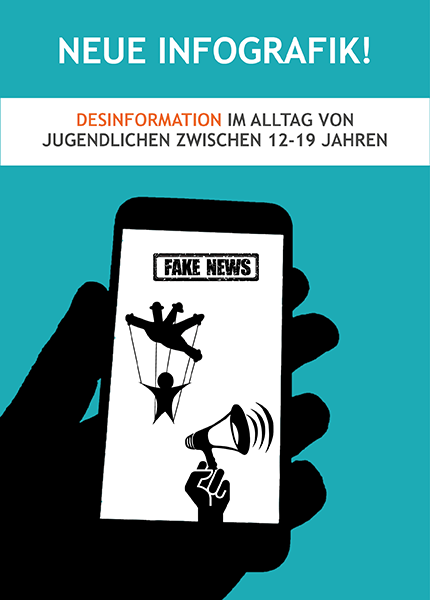klicksafe infographic: Disinformation in the everyday lives of young people
The Corona pandemic will also dominate the Internet in 2020. Fact checkers such as mimikama.at and CORRECTIV observed a sharp rise in deliberately spread misinformation and conspiracy theories as early as spring. The new study by the Vodafone Foundation shows: Three quarters of young people in Germany are regularly confronted with fake news. Many would like support - from their schools, among others. The extent to which disinformation plays a role in the everyday lives of young people between the ages of 12 and 19 was also recorded in the current JIM Study 2020.
A total of 1,200 young people were asked, among other things, whether they had encountered fake news, conspiracy theories and extreme political views within a month:
Fake News
Fake news, i.e. deliberately spread false news, is mainly disseminated via social networks and messengers. In other words, precisely the communication channels that play an important role in the lives of young people. According to the JIM study, one in three young people said they had come across fake news online. Young people with a formally lower education (42%) and the 12-13 age group (45%) are the most likely to report having noticed fake news, according to the JIM study.
Conspiracy theories
The prevalence of conspiracy theories increased overall in 2020, primarily due to the spread of conspiracy narratives surrounding Corona. Among the young people surveyed, 43% said they had come into contact with conspiracy theories. Again, the breakdown by age group, education, but also gender, shows a difference. While only 27% of young people between the ages of 18 and 19 stated that they had come into contact with conspiracy theories, the figure for the age group between 12 and 13 is 60%. Differences are also evident among youth with less formal education (55%) compared to those who go to high school (35%), as well as among girls (46%) and boys (39%).
Extreme political views
In addition to fake news and conspiracy theories, young people are also exposed to extreme political positions on the net, such as right-wing extremist statements. In the JIM study, almost half of all young people surveyed (45%) reported having experienced extreme political views on the Internet. It is also evident that younger people between 12-13 years (63%) and between 14-15 years (59%) as well as young people with formally lower education (55%) are more frequently affected by contact with such content.
Disinformation and opinion forming as a theme of Safer Internet Day 2021.
Whether fake news and conspiracy narratives, elections infiltrated with disinformation or baseless rumors: Anyone who informs themselves on the Internet is exposed to a wide range of news, some of which is not news at all. klicksafe is making "Opinion formation between fact & Fake" the theme of Safer Internet Day 2021. Until February 9, we will provide different suggestions and materials for dealing with the topic.
Get involved! Whether it's a project day at school, a parents' evening at a daycare center or a media workshop at a youth center - your own events on the topic of disinformation and opinion forming or other topics related to safety on the Internet can be Sign up now become.
Hashtags for SID2021: #sid2021 #WhoMakesMyOpinion.
- Information & SID 2021 materials.

